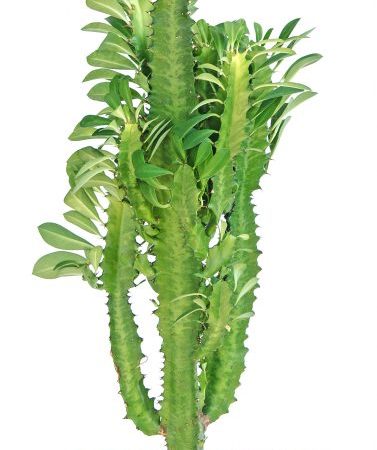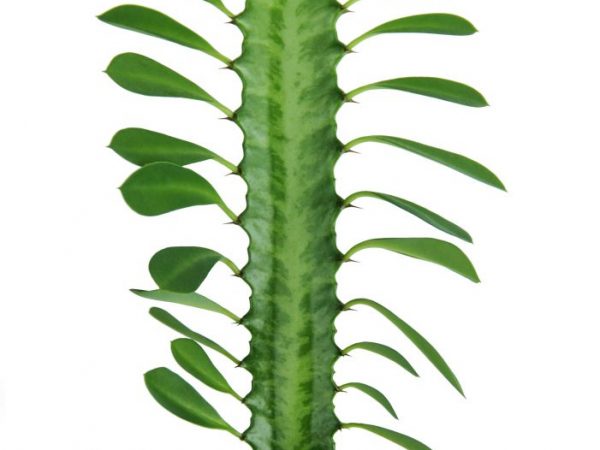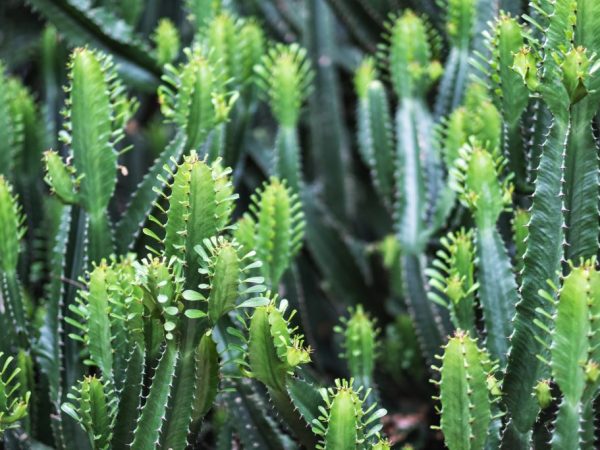Euphorbia Triangular - features of growing a subtropical flower
Triangular spurge, or triangular, is a large houseplant, not much like a cactus. With proper care, it can grow up to 3 meters. It is appreciated by flower growers for the minimum requirements for growing conditions and an interesting appearance.

Euphorbia Triangular - features of growing a subtropical flower
Description
Another name for the plant is Euphorbia trigona (Latin Euphorbia trigona).
Euphorbia is native to the subtropics of Africa, often found in Madagascar. In the natural area, the culture is represented by a tree, located mainly on dry hills.
It has a fleshy stem with characteristic three facets and pronounced ribs. The latter have small spines with small leaves located closer to the top of the shoots.
In the course of development, it forms several productive shoots, in connection with which many are compared with a candelabrum, which resembles in appearance.
Most of them are colored deep green. However, there are extremely rare specimens with reddish stems and deep crimson leaves.
In indoor conditions, the plant develops quite actively and is quite capable of reaching 3 m, if the height of the room's ceilings allows it.
With minimal care, it can delight with its decorative qualities for many years, which attracts florists even though the culture does not bloom.
Purchase and adaptation
When buying a plant, it is necessary to closely examine, even if it visually looks healthy. Symptoms of diseases or the vital activity of parasites include stickiness on the surface of the shoots, spots, softened areas.
Immediately after the pet is at home, it should be gently rinsed under a slightly warm shower and only then quarantined for a couple of weeks. This time is enough for the flower to adapt to the conditions provided.
After this period, the culture is transported to new soil, having previously removed the old roots as much as possible.
Landing
It is preferable to hold the event in the spring. The pot is chosen based on the size of the succulent itself. Ideally, it should be quite wide due to the superficial location of the root system and not very high.
It is also recommended to change the top layer of the substrate every season.
When transplanting large plants, rather weighty stones are laid out on the bottom, which gives Euphorbia stability. Moreover, drainage is one of the important requirements during the procedure, regardless of the age of the succulent.
The necessary conditions
Microclimate
| Humidity | Temperature | Lighting |
| The triangular representative of milkweed is not picky about air humidity. To maintain health, the plant follows sprays and a gentle soul In the latter case, the soil must first be protected with plastic wrap. | A succulent plant does not tolerate sudden temperature fluctuations. During the growing season, the best option is to maintain room temperature. In winter, when Euphorbia is at rest, they are reduced to 15-18 °. | He feels good both in partial shade and under diffused sunlight, therefore he is not at all capricious in relation to the degree of illumination of the room. |
Seat selection

The plant grows successfully at home
The pot with the plant can be placed both on an open windowsill and in a secluded corner of the room. The exception is windows with access to the north side.
It may well grow in a greenhouse or on a loggia. However, it is necessary to accustom the culture to direct exposure to sunlight gradually so as not to provoke the formation of burns on the leaves.
Soil selection
Euphorbia needs well-drained loose soil, which is characterized by a high degree of air permeability.
For planting, you can take a purchased substrate for succulents and cacti, or you can make it yourself. Mix in equal proportions:
- peat;
- river sand;
- leafy ground;
- turf.
Additionally, the pot is equipped with a drainage layer of brick chips to avoid liquid stagnation in the container.
Home care
Euphorbia Trigona is a godsend for beginner inexperienced flower growers. It is able to grow quite comfortably in indoor conditions.
Fertilizers and feeding
From spring to autumn, when the flower is in the growing season, it is fed with specialized preparations for succulents. In this case, the procedure is carried out monthly.
It is not recommended to use one-component formulations - there is a possibility of harm to the bush.
The reason for the appearance of small white spots is in the excessive amount of nitrogenous compounds in the soil, and this phenomenon is just milky sap that has emerged through minor damage.
This is due to the fact that due to the high content of organic matter in the soil, the plant begins to gain volume and, as a result, burst.
Watering
Trigona tolerates short-term drought quite comfortably. Waterlogging is much more destructive for a bush than a short thirst. However, for better development, the earthen coma should not be allowed to completely dry out.
During the growing season, watering is carried out once a week. In the winter season, the number of procedures is significantly reduced.
Additionally, it is worth paying attention to the pallet - stagnant water in it can provoke rotting of the root system.
Also, sanitary cleaning of the surface from settled dust, which is done with a dry soft brush, will not be a superfluous measure.
Transfer
The transplant principle is identical to almost all indoor plants. For young specimens, annual transportation is required, for older ones - once every 2-3 years. In this case, in the latter case, they are guided by the degree of filling the container with roots.
Pruning
The absence of a haircut will allow the triangular milkweed to reach an impressive height, which is not always acceptable for standard apartments. Therefore, in the case of a limited space of the room, trimming is carried out.
Manipulations are carried out with a well-sharpened knife at the required level, after which the injured area is sprinkled with crushed activated carbon.
In the future, the plant forms side shoots and changes its original shape, becoming more like a sprawling shrub.
If you do not want to trim, it is allowed to cover the crown of the head with a kind of cap, for which a cork from a plastic bottle is quite suitable. As a result, the flower will stop growing and will use forces to form secondary processes.
Reproduction methods

Euphorbia reproduces by children
Trigona can be most productively propagated by the vegetative method; the segments located on the sides are used as inoculum.
Technology:
- Young cuttings, up to 10 cm in length, are cropped, while pruning is done with a margin.
- Dry for 2-3 days. After that, the wounds are treated with crushed coal.
- Placed in wet sand or perlite. In order to more successfully root the plant, it is determined in a sufficiently illuminated place so that direct sunlight does not fall on the shoot.
- When signs of growth activation appear, they are transplanted into another container.
Diseases and pests
Due to the fact that the plant is considered poisonous due to its milky sap, it is extremely rarely attacked by pests. However, sometimes the succulent is attacked by aphids, spider mites and mealybugs.
It is worth regularly examining the green pet for insects.
| Insect | Description, signs | Treatment |
| Aphid | It is mainly located on the inner side of leaves or completely covers the surface of young shoots. The affected parts twist, turn yellow, fall off. Spreads from other plants or through an open window. | Spray with infusion of nettle / onion, a solution of laundry soap with alcohol. Insignificant colonies can be exterminated by regular showering and cutting off the most injured segments. |
| Spider mite | Appears in case of excessive dryness. Looks like a microscopic arthropod. Initiated along a thin white spider web. | Eliminate the affected areas, wash the entire plant under running water. Then they are treated with systemic drugs: Akarin, Fitoverm, Karbofos. It is allowed to use a soap or alcohol solution. |
| Mealybug | At the first stage, inhibition of the growth of the succulent is observed, after a complete stop in development. You can identify an insect by the sticky trail left by the parasite. | Mechanically removed with a cotton swab dipped in alcohol, then treated with chemicals (Bankol, Aktellik, Inta-Vir, Commander) |
If you care for a succulent without relying on its requirements, there is a possibility of certain problems:
- The plant begins to actively shed leaves, which is caused by excessive watering.
- Leaves turn yellow - as a result of excessive feeding.
- Brown growths are formed in the case of prolonged exposure to milkweed under the influence of direct sunlight.
Benefit and harm
The plant is considered poisonous, which must be taken into account if there are children or animals in the family.
Beneficial features
Euphorbia purifies the air and fights harmful bacteria. Many people place a flower near a computer in order to minimize the negative effects of electromagnetic waves, mistakenly confused with a cactus. He will not be able to cope with such an influence, but he will fully tune in to productive work.
It is not worth keeping a pot with a majestic handsome man in the bedroom, which is due to the subtle scent of the plant. As a result, irritability and sleep disturbance can occur.
In ancient times, it was used to remove warts, calluses and various diseases. Indian medicine men used succulent root powder as an antidote for snake bites.
True, modern doctors are ardent opponents of this technique. Despite the experience of ancestors, they note the toxicity of the culture.
When interacting with the skin, milky juice can provoke severe irritation, and even a small drop of milk that gets on the tongue causes numbness.
Before pruning or replanting euphorbia, it is worth stocking up on protective gloves, and after the procedure, wash your hands thoroughly with soap and water.
Signs and superstitions
If you rely on signs and superstitions, then there is no definite opinion whether it is possible to keep Euphorbia Trigon at home. According to some sources, the plant brings negativity into human life. Many believe that culture should not be put in a sitting area or bedroom, which is especially true for married couples. This is due to the presence of thorns, which symbolize tension in a relationship.
Others, on the contrary, assure that this flower has a positive effect on energy flow. Thanks to its life-giving power, the home shrub is able to give peace and inspiration to all households, as well as solve problems with the musculoskeletal system.
You can safely grow succulents in the office. According to the beliefs of its owner, it will bring good luck, success in career growth and positive attitude of colleagues.



